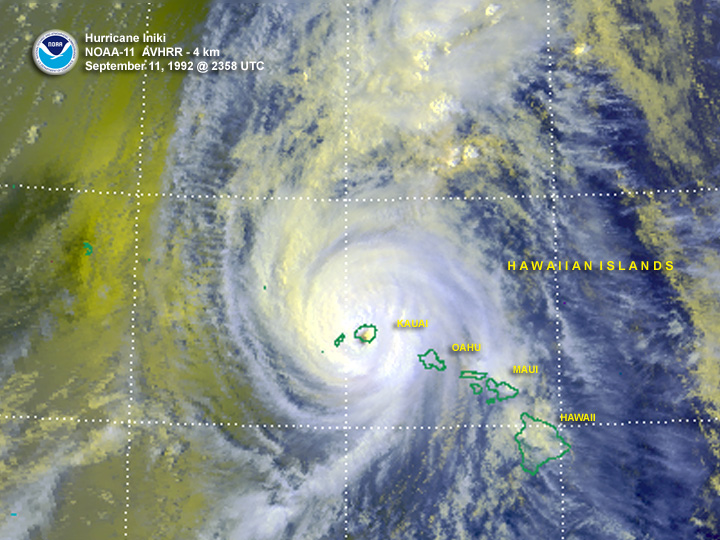Hawaiian Storm Names

Hurricanes in the Central Pacific have their own unique identity, not just in their formation and trajectory, but also in how they’re named. In Hawaii, storms are named using Hawaiian words, reflecting the deep cultural significance of the islands’ native language. However, the process of naming these storms has a history that’s both fascinating and complex, particularly when it comes to the meanings of the names and their implications.
I’ve always found it interesting how something as powerful and destructive as a hurricane can carry a name that’s so culturally rooted. But as I delved deeper into this topic, I learned about two specific Hawaiian storm names—Iwa and Iniki—that left a lasting mark, not only because of the damage these storms caused but also due to the meanings behind their names. In Hawaiian, Iwa translates to “thief,” and Iniki means “to nip or pierce.” Looking back, it’s almost as if these storms lived up to their names, stealing away normalcy and piercing the heart of the islands with their devastating impacts.
Hurricane Iwa, in 1982, was a Category 1 storm but caused catastrophic damage, especially to Kauai, with losses estimated at around $250 million. Then came Hurricane Iniki in 1992, the most powerful hurricane to ever strike Hawaii. A Category 4 monster, Iniki devastated Kauai again, leaving six people dead and causing more than $3 billion in damage. The eerie accuracy of these names’ meanings wasn’t lost on the community, and they sparked conversations about the cultural and emotional implications of naming storms.
Recognizing this, a significant change was made. The National Oceanic and Atmospheric Administration (NOAA), the organization responsible for tracking and naming storms in the Central Pacific, partnered with Native Hawaiian language professors to revise the list of storm names. Together, they created a new list that honors the Hawaiian language while removing names with negative or ominous connotations. This collaborative effort ensured that future storm names would respect the cultural significance of Hawaiian words while avoiding any unintended associations with the destruction these storms might cause.
The naming process for hurricanes in the Central Pacific is different from other parts of the world. While storms in the Atlantic or Eastern Pacific use a pre-determined rotating list of names in English, Spanish, and French, the Central Pacific uses a list of Hawaiian names. This not only reflects the geographical uniqueness of the region but also highlights the importance of integrating local culture into global systems. For Native Hawaiians, their language is a vital part of their identity, and the opportunity to use Hawaiian names for storms offers a way to celebrate and preserve this heritage.
The revised list now includes names that are carefully chosen to avoid negative meanings while maintaining cultural significance. For example, names like Akoni and Hekili—meaning “Anthony” and “thunder,” respectively—are part of the new roster. This approach brings a thoughtful balance: it honors the language and culture without unintentionally evoking fear or reinforcing the destructive nature of hurricanes.
It’s worth noting that naming storms isn’t just about culture; it serves a practical purpose as well. Names make it easier to communicate important information about a storm, especially during emergencies. Imagine trying to track multiple storms at the same time without distinct names—it would be confusing for forecasters, officials, and the public alike. In Hawaii, using Hawaiian names adds another layer of connection for residents, making the storm feel more immediate and relevant to their lives.
What I find particularly inspiring about this story is how it reflects a broader commitment to cultural sensitivity and inclusion. Involving Native Hawaiian language experts in the process ensured that the revisions were thoughtful and respectful. It’s a reminder of the power of collaboration and the importance of listening to the voices of the community when making decisions that impact them.
The Central Pacific Hurricane Center (CPHC), based in Honolulu, plays a key role in tracking storms in this region. The center is responsible for issuing advisories and warnings for tropical cyclones that develop or move into the Central Pacific Basin, which spans from the equator to 140°W longitude. While Hawaiian-named storms are relatively rare compared to those in the Atlantic or Eastern Pacific, their cultural impact is profound. When a storm forms or moves into this area, it’s not just a meteorological event—it’s a moment that ties science, community, and culture together.
The decision to update the storm names is also a reflection of how the understanding of language evolves over time. Words carry weight, and their meanings can influence how people perceive events. By carefully selecting names with positive or neutral meanings, the NOAA and Native Hawaiian collaborators have taken an important step in shaping how these storms are remembered.
To me, the story of Hawaiian storm names is about more than just hurricanes. It’s about the power of language and its ability to connect people to their history, culture, and environment. It’s about recognizing the impact that words can have, even in something as seemingly straightforward as naming a storm. And it’s about the resilience of a community that, despite facing the immense power of nature, continues to honor its heritage while adapting to the challenges of the modern world.
In the end, Hawaiian storm names represent a unique intersection of culture, science, and tradition. They’re a reminder of the importance of preserving language and heritage, even in the face of something as unpredictable and powerful as a hurricane. By choosing names thoughtfully and respectfully, Hawaii has shown that even in the most challenging times, it’s possible to find a way to honor the past while looking toward the future.